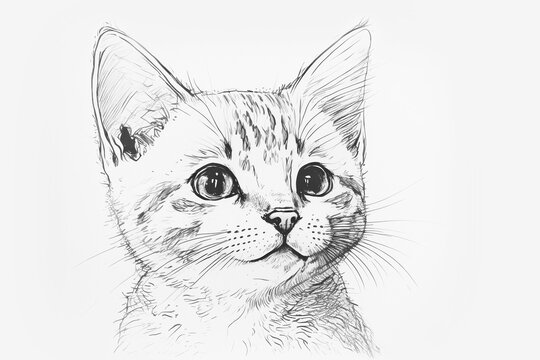Mastering the Craft of Drawing:a4z_-ymtkr8= Cat
If you are an artist just starting with your journey or if you just wish to improve your drawing skills, Drawing:a4z_-ymtkr8= Cat is for sure to be both exciting and fulfilling.
Drawing a cat is a truly challenging yet exciting project since those mysterious creatures pose a real challenge for any artist. Let this guide teach you the fundamental techniques that you will need to create realistic and expressive cat drawings; from mastering cat anatomy to perfecting cat fur texture details.

Drawing:a4z_-ymtkr8= cat – Understanding Feline Anatomy
Before diving into the drawing process, let’s first understand the anatomy of a cat. Their unique body structure is characterized by agility and grace. It forms the foundation of any realistic drawing.
Here are the key anatomical features in brief:
Head: Generally, a cat’s head is round. It has a strong muzzle. Do not forget about big, almond-shaped eyes – they are usually highlighted in drawings, as cats are extremely expressive animals.
Body: The body of cats is elongated and quite slim. Besides, it is supported by the flexible spine and the ability of the creature to contort variedly.
Legs: They are strong and quite muscular but taper to the small paws to stress the element of might and precision.
Tail: The tail of a cat serves a meticulous role when maintaining balance and communication with other creatures. It may vary in size and form – straight, bushy, curved. It also shapes the personality of your drawing.
Drawing:a4z_-ymtkr8= cat : Sketching the Basic Shape
The first step in Drawing:a4z_-ymtkr8= cat is to outline the basic shapes that form the cat’s body.
Start with simple circles and ovals to represent the head, torso, and limbs. This foundational sketch ensures that the proportions are correct. It is a guide for adding more details later.
- Head: Begin with a circle to outline the head. Then, come up with a guide for the nose, eyes, etc. and especially the mouth to ensure proper placement.
- Body: Draw an elongated oval for the torso. Reflect the cat’s lithe, flexible form.
- Legs and Tail: Simple lines can sketch good legs/ tail position. Remember the cat’s overall posture while drawing legs and tail.
Adding Details: Eyes, Ears, and Nose
With the basic shapes in place, it’s time to focus on the details. They will bring your cat drawing to life. The eyes, ears, and nose are critical elements that define a cat’s character.
- Eyes: The eyes are one of the most expressive features in Drawing:a4z_-ymtkr8= cat. Capture their shape and position with precision. Add slight curves to the top of the eyes for a natural look.
- Ears: Place the ears slightly higher on the head. Draw them as triangles. Give good care to the texture in the ears to add depth.
- Nose: A cat’s nose is small. Typically, it’s shaped like an inverted triangle. Use shading techniques to add dimension and realism.
Incorporating Fur Texture
Fur texture is a crucial aspect of Drawing:a4z_-ymtkr8= cat. It can significantly impact the overall realism of the artwork.
Here’s how to achieve various fur effects:
- Short Fur: For short-haired cats, use quick, short strokes to mimic the fine fur.
- Long Fur: For long-haired breeds, use longer, flowing strokes. Vary their direction to create a natural and realistic appearance.
- Shading: Apply shading to areas like the belly. Under the chin and inside the ears, add depth. Now, enhance the three-dimensional quality of your drawing.
Capturing Movement and Posture
Cats are known for their fluid, graceful movements. Capturing this in your drawing requires careful attention to posture. No matter if the cat is lounging or stalking, your goal is to convey a sense of motion and balance. It reflects the cat’s natural behavior.
Typical Cat Breeds & Their Special Features
Different cat breeds have distinctive features that set them apart. Understanding these traits will help you accurately depict various breeds in Drawing:a4z_-ymtkr8= cat.
| Cat Breed | Distinctive Features | Coat Type |
| Siamese | Slender body, large ears, light blue almond-like eyes | Short, fine coat |
| Maine Coon | Large size, tufted ears, bushy tail | Long, thick coat |
| Persian | Round face, short muzzle, large eyes | Long, dense coat |
| Sphynx | Hairless, wrinkled skin, large ears | None |
| Bengal | Leopard-like spots, muscular build | Short, dense coat |
Drawing:a4z_-ymtkr8= cat” from Different Angles
To master drawing:a4z_-ymtkr8= cat, practice sketching the cat from various angles.** This exercise will help you learn how a body of a cat changes from different perspectives. So when you draw a cat, your picture will not look static but quite dynamic and realistic.
Front View
This side will help you include the symmetrical face and see how it looks in all the angles. First of all, create a symmetrical face. Pay attention to the eyes and the ears and the distance between them.
Side View
Pay heed to the back of cat on this side. The second thing you must include after the exact back is the legs. They play an immense role too, and it is important to place them correctly.
Three-Quarter View
This side will be the most difficult because it incorporates the essential features of both the front and the side view. However, it will also be the most fun to sketch the cat from this angle.
Conclusion
Drawing:a4z_-ymtkr8= cat is a mash of technical wizardry and art vaccinations have controversy issues.
Learning the anatomy, further developing your technique and practicing different perspectives will allow for you to take your cat drawings an extra mile towards realism or artistry. Either you are in beginner stage or practicing harder, the above mentioned tips will help you to develop nice cat sketches with having realistic look.



